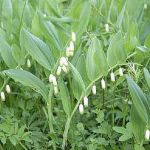| Common Name: |
Sealroot |
| Other Names: |
Angled Solomon's Seal, Dropberry, Lady's Seals, Sealwort, Solomon's Seal, St. Mary's Seal |
| Botanical Name: |
Polygonatum odoratum syn. P. officinale, P. multiflorum |
| Genus: |
Polygonatum |
| Family: |
Convallariaceae |
| Native Location: |
Europe and Asia |
| Cultivation: |
Well-drained, moist, rich soil in part shade, or in sun with a cool root run. Leaves may be damaged by sawfly caterpillars. |
| Propagation: |
By seed sown in autumn; by division in early spring. |
| Harvest: |
Rhizomes are lifted in autumn and used fresh in tinctures and ointments, or dried for use in decoctions and powders. |
| Warning: |
All parts, especially the berries are harmful if eaten. |
| Varieties: |
Flore Pleno
Has double flowers. |
Gilt Edge
Has yellow-margined leaves. |
Variegatum
Has white-margined leaves. |
|
| Height: |
85cm (34in) |
| Width: |
45cm (18in) |
| Hardiness: |
Z3-9 |
| Parts Used: |
Rhizomes (yu zhu), Roots |
| Properties: |
A bitter-sweet, astringent, tonic herb that acts as an expectorant, soothes irritated or damaged tissues, reduces inflammation, and clears toxins. |
| Medicinal Uses: |
Internally, in Chinese medicine, for heart disease, tuberculosis, dry cough, dry throat in diabetes, and to encourage the secretion of body fluids. In Western herbalism, internally for coughs and gastric irritation; externally for bruises, broken nose, hemorrhoids, rupture, and dislocations. Internally, in Ayurvedic medicine, as a rejuvenative and aphrodisiac; one of eight root herbs (mostly belonging to the lily family) known as ashtavarga, used for infertility, insufficient lactation, chronic wasting diseases, or bleeding disorders related to kidney weakness. Given with warm milk and ghee as a tonic.
To treat respiratory and lung disorders, bruises, hemorrhoids, redness of the skin, finger ulcers, or boils. |
| Possible Side Effects: |
Solomon's seal's side effects include gastrointestinal irritation. |
| Drug Interactions: |
| Taking Solomon's seal with these drugs may increase the risk of hypoglycemia (low blood sugar): |
| Acarbose, (Prandase, Precose) |
Acetohexamide, (Acetohexamide) |
Chlorpropamide, (Diabinese, Novo-Propamide) |
Gliclazide, (Diamicron, Novo-Gliclazide) |
| Glimepiride, (Amaryl) |
Glipizide, (Glucotrol) |
Glipizide and Metformin, (Metaglip) |
Gliquidone, (Beglynor, Glurenorm) |
| Glyburide, (DiaBeta, Micronase) |
Glyburide and Metformin, (Glucovance) |
Insulin, (Humulin, Novolin R) |
Metformin, (Glucophage, Riomet) |
| Miglitol, (Glyset) |
Nateglinide, (Starlix) |
Pioglitazone, (Actos) |
Repaglinide, (GlucoNorm, Prandin) |
| Rosiglitazone, (Avandia) |
Rosiglitazone and Metformin, (Avandamet) |
Tolazamide, (Tolinase) |
Tolbutamide, (Apo-Tolbutamide, Tol-Tab) |
|
| Supplement Interactions: |
May increase blood glucose-lowering effects and risk of hypoglycemia (low blood sugar) when used with herbs and supplements that lower glucose levels, such as alpha-lipoic acid, chromium, Devil's Claw, Panax Ginseng, and Psyllium. |
| Bibliography: |
The Encyclopedia of Herbs by Deni Bown Copyright © 1995, 2001 Dorling Kindersley Limited. pp 326-327.
The Essential Herb-Drug-Vitamin Interactions Guide by Geo. T. Grossberg,MD and Barry Fox,PhD Copyright©2007 Barry Fox,PhD. Pp. 424-425 |
